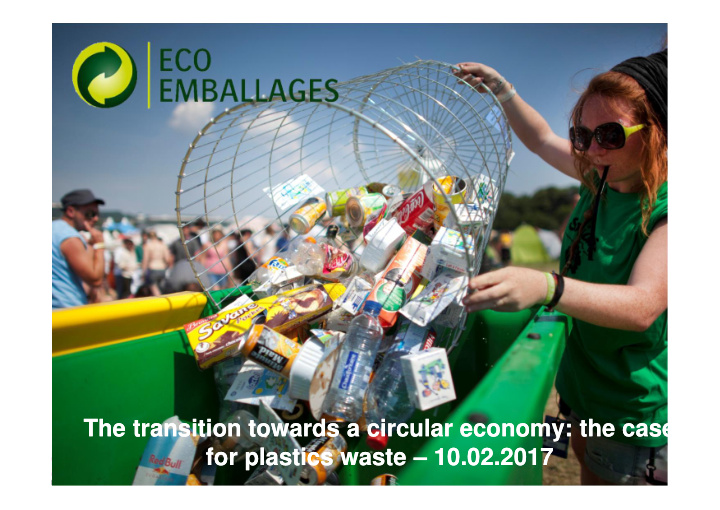



The transition towards a circular economy: the case The transition towards a circular economy: the case for plastics waste – 10.02.2017 for plastics waste – 10.02.2017
GENERAL OBJECTIVES Give French consumers the opportunity to sort more and better (not only plastics packaging but all materials) Increase the recyclable part of plastic packaging while reaching an economic, social and environmental optimum Develop other recovery options for packaging that are - and will remain - non recyclable (energy, RDF, …) Define collection and sorting organizations allowing to control and reduce costs Guarantee recycling , develop markets and applications for recycled resins
5MT OF HOUSEHOLD PACK AGING IN FRANCE GLOBAL RECYCLING RATE: 67% METAL: 108% <0,1 MT ALUMINIUM <0,1 MT ALUMINIUM 15 billions units GLASS: 85% PAPER/CARDBOARD: 67% 0,3 MT METAL 0,3 MT METAL BRICKS: 45% 6 billions units PLASTICS: 23,8% 1 MT 1 MT 50 billions units ALUMINIUM : 35% PAPER/CARDBOAR PAPER/CARDBOAR D/BRICKS D/BRICKS 100 billions units 1,2 MT PLASTICS 1,2 MT PLASTICS 9 billions units 2,4 MT GLASS 2,4 MT GLASS National target of 75% of recycling by 2022
56% of plastics packaging are expected to be recycled in 2030 (+ 400,000 t) Today’s Estimate for Estimate for situation 2022 2030 Plastic packaging sold on French market 1 090 1 147 1 207 (kt/year) Of which Bottles 435 445 449 Trays, pots and other rigids 375 396 424 Films 280 305 334 Packaging waste recycled (kt/year) 256 445 675 Of which Bottles 250 311 368 Trays, pots and other rigids 4 100 232 Films 2 34 75 Plastic packaging recycling rate 23% 39% 56% 57% 70% 82% Of which Bottles 1% 25% 55% Trays, pots and other rigids 1% 11% 23% Films 4
IMPLEMENTATION BY MUNICIPALITIES AND SORTING CENTRES TARGETS REACHED END OF 2016 15M inhabitants 36 modernised 9 new pilot sort all packaging sorting centres sorting centres + 2 kg/inhab/year of new plastics + same effect for other materials 5
FOCUS ON THE NEW STREAMS & THEIR MARKET PET bottles, & flasks Already in place PET trays & pots PEHD/PP , bottles, & flasks Already in place PEHD,/PP trays & pots Flexible films Already in place, to be PEBD/PEHD consolidated PS/XPS/PSE trays & pots Difficult to sort, limited outlets Complex /multilayer PET trays Design to improve & pots; PP/complex or too recyclability or energy tiny flexible films recovery PVC Non conclusive recycling tests : chlored plastics not fit for energy recovery. Elimination as a waste. 6
Increasing plastics packaging recyclability w ith packers & fillers Reducing aluminium: Packaging Guide of best practices: ALBEA, ELVIR innovation: SYNDIFRAIS MERALLIANCE Mono-material trays: KERMENÉ, ELIVIA, HERTA, BEL 7
CONCLUSIONS • Need to involve all actors of the packaging value chain: Packers & fillers (« design for recycling ») Consumers (in sorting their waste properly) Municipalities (optimised selective collection) Recycling industry (expertise sharing) • Need to modernise sorting: fewer sorting centres (240 today, i.e. an average of 1 for 250,000 inhabitants), automatisation, industrialisation • Need for a stable and well-defined quality of recycled materials so as to allow sound market developments, to ensure outlets, and to avoid dependency on exports 8
Recommend
More recommend